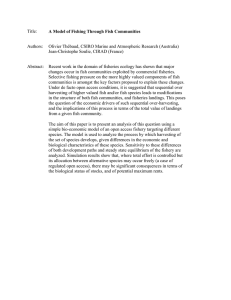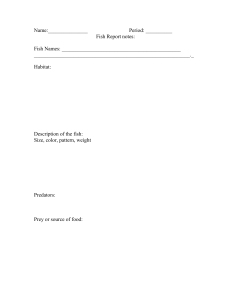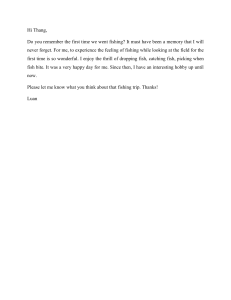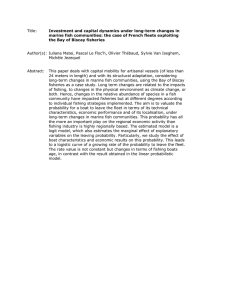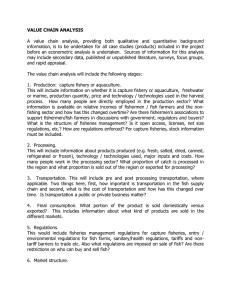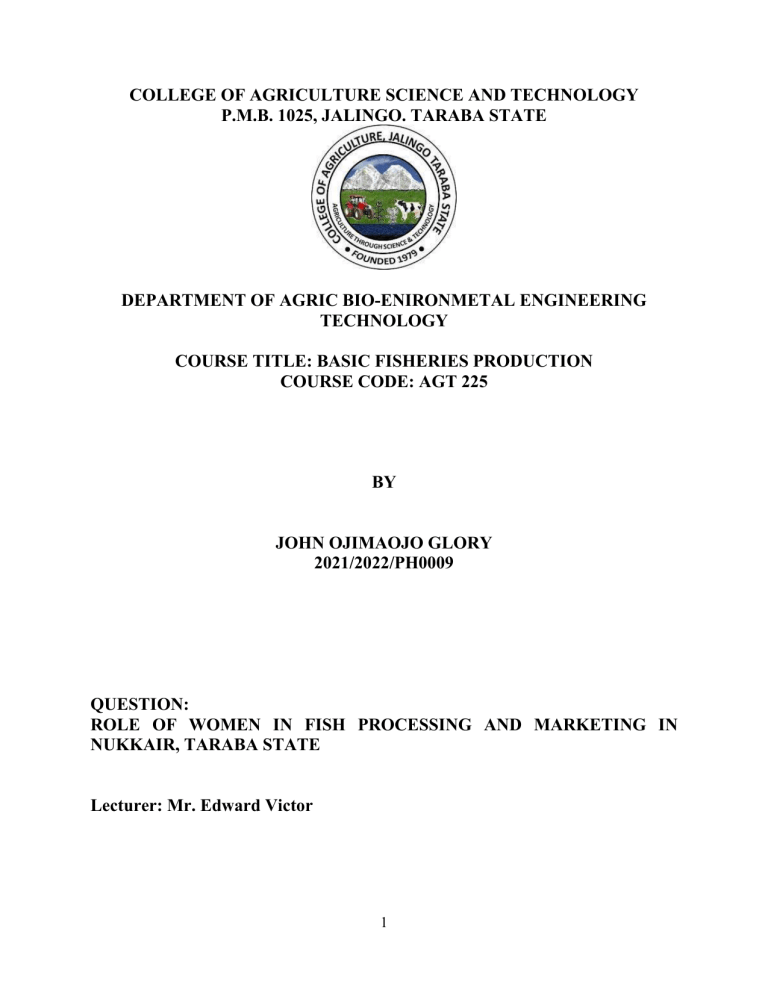
COLLEGE OF AGRICULTURE SCIENCE AND TECHNOLOGY P.M.B. 1025, JALINGO. TARABA STATE DEPARTMENT OF AGRIC BIO-ENIRONMETAL ENGINEERING TECHNOLOGY COURSE TITLE: BASIC FISHERIES PRODUCTION COURSE CODE: AGT 225 BY JOHN OJIMAOJO GLORY 2021/2022/PH0009 QUESTION: ROLE OF WOMEN IN FISH PROCESSING AND MARKETING IN NUKKAIR, TARABA STATE Lecturer: Mr. Edward Victor 1 2 1. Introduction The contribution of women is vital in the food production systems of agriculture and fisheries. Thousands of women have been working in the fishing industry throughout history and across nations. Their role differs across fishing industries, communities, countries and regions. However, most women devote their efforts, talents and skills to the wellbeing of the family through their engagement in the fishing industry. Women play great role in the subsistence and small-scale fishery production, mostly in the primary production systems. In the case of developing countries where capital equipment was insufficient, as may still be the case, women play an important role in fishing which was more a means of subsistence than industry. However, as capital equipment increased and modern fishing for commercial production developed, women began to be excluded from fisheries. The role of women has not completely disappeared; it is gradually disappearing in developed countries, but still prominent in developing countries. For instance, the far eastern countries with the aging populations have a decreasing number of women attached to fisheries industry and showing enlarging numbers of women leaving the industry. Women and their roles play very important part in the fishing industry as workers and as the sex that gives birth to successors. Moreover, industrial development of the South East Asian countries and the increasing trend of women’s engagement in industrial labor discourage them from involving in the fishery industry. Especially, comfortable, safe and advanced working environment attracts more youth participation in industrial labor force than the traditional production systems of fishery. In the industrial nations women’s participation is concentrated at finishing ends of the fishery value chains while female fishers are more concentrated at opening sections of the developing country fishery value chains. Traditionally, fish catching received central attraction by men where they played a leading role and female roles were mainly dedicated to fish handling, grading and small-scale home based processing. Therefore, the reason for the invisibility of women in the fishing industry lies in the fact that the activities of women engaged in fisheries and related work are largely ignored (Hitomi, 2009). The structure of women’s role in capture fisheries and aquaculture differs across community, country and region. The fisheries sub-sector is a significant source of fish food and livelihood for many people living in Nukkai, Taraba State, as it supplies animal protein necessary for growth and income for many households in these rural communities ( Akinrotimi et al., 3 2007). Women have been reported to play a vital role in fishery related activities around the world, especially in the Nukkai environment, where these activities are classified majorly in three ways; fishing, processing and marketing ( Olufayo, 2012). Their role in food production, like fishery has become more relevant as a way of reducing poverty and enhancing food security. Worldwide, women in fishing communities have been observed to participate actively in fisheries and also play a part in the maintenance of their families ( Nwabeze et al., 2013). In many parts of the world, women have engaged actively in fish business. In the European countries for instance, women control 39% of the fish industry, making a huge amount of money for themselves and their families ( Aquilar, 2002). The crucial engagement of women in natural resources-based occupation such as fisheries in the rural communities has long been accepted but not recognized and not valued as men contribution (Obetta et al., 2007). However, fish production is customarily considered as masculine venture, women role in fish related activities is though supportive, is imperative and indispensable ( Cliffe et al., 2011a). However, their role is repeatedly being ignored and relegated, consequent of primordial systems of social setting, that is prevalent in the rural areas of many developing countries like Nigeria (Ibrahim et al., 2011). Tamale (2004) reported that the non-recognition of women contribution in production process is enhanced by uneven allocation of resources. Therefore, lack of access and control over productive process is one of the major factors limiting women participation in economic activities such as coastal fishery practices (Acharya, 2003). Women in rural areas participate actively in the traditional fisheries sub-sector of the economy. They are either fully involved or play a complementary role for men in provision for their families. There is therefore the need to promote and to encourage women folk in this sector, so as to boost supply of food fish and improve the economic welfare of their families ( IFAD, 2008; Ekpo, 2013). Fisheries is an important activity, that is predominant in Nukkai, Taraba State, the role of women in fisheries related activities in these areas are very crucial and critical to 4 the overall economy of the state but policy maker usually overlook the import ant role that women play in fisheries activities. Role of women in fish processing and marketing 2. Female hands on fishery value chain Value chain analysis based on gender is focusing on forward and backward linkages and the aim is to maximise returns for both men and women who are engaged at different levels of the value chain- which shows gender involvement in the fishery value chain. A gendered value chain analysis is designed to highlight the different positions and contributions of men and women across the value chain and uncover the economic, organizational, and coercive relationships among actors located along different points of the fishery value chain. The analysis will illuminate the distribution of potential and actual benefits, delegation of authority, resource ownership to these actors. Analysing the fishery value chain, and the rents generated provides opportunities to target assistance and provide incentives to reduce the number of intermediaries, increase the bargaining power of gatherers and small scale farmers, and ensure access appropriate processing technology, storage and transport facilities to enable resource poor gatherers to capture more of the value added products in the global value chain. 2.1 Production Traditionally women’s roles were centered more on household activities, such as meal preparation, child care, elderly care, educating children and supportive role to fishers. Supportive role mainly focused on domestic fish processing, handling and grading. In general, domestic fish processing with traditional technology aims to provide processed fish for home consumption and to share the excess amount with extended family. Moreover, most women’s physical appearance is generally inferior to men’s which de-motivate them from participating in the fish catch. In addition, the cultural and societal beliefs also limit their engagement in fishing. For instance, most of the Nukkai Market fishing communities believe that woman on board make bad luck. In most cases, women have been eliminated from “catching” and have not been present at the “catch” sites (Hitomi, 2009). In particular, as modern capital equipment has become standard, women have been excluded from the actual fishing places (Hitomi, 2009). However, today many women have been involved in many important aspects in the fishery value chain. Female roles are identified as important supportive roles which facilitates the smooth 5 functioning of fishery value chains. Aging population and departure of some employees from fisheries has become a new hope for women, both as replacement for male workers and as the bearers of next generation of succors (Hitomi, 2009). Female participation in fish production was incurred with the emergence of aquaculture. Women play important roles in giant aquaculture production destinations, Nukkai aquaculture giants accounts for 90% of the world supply and their production systems is based in rural areas with integration of the current farming systems. Moreover, most of the production systems are smallscale and depends heavily on family labor, where the involvement of female hands and their contribution is great. 2.2 Handling and Grading In general, almost all women in fishing communities around the world are playing great role in fish handling and grading. In general men have higher status and they have more power and authority than women. Cultural barriers and household roles discourage women from participating in the high value ends of the fishery value chains. Especially in modern fishery value chains, women are often segregated in certain nodes which brings less returns and not attractive to new entrants. Female participation in lower level nodes of the value chain which require relatively unskilled labor. Their participation is common in processing and packaging levels as a daily paid factory worker. 2.3 Distribution Female fish mongers playing important role in the domestic fish markets female vendor in Nukkai central fish market. Moreover, women are engaged in traditional small-scale fish processing for the local markets and their involvement is becoming popular with the emergence of ethnic markets. In general high value end of the fishery value chain is handled by men all over the world with the exception of few cases while women remain in low value end. The modern value chains with few nodes make fewer women participation than in traditional value chains. Their access to modern value chains is less due to poor access rights to assets, credit services, markets and information on new technology, consumer performances and export trade. 2.4 Fish Retail Both men and women engage in fish retailing, and female participation in traditional retailing is high in most fish markets in Nukkai market. 6 The retailers sell their fresh fish to local hotels, restaurants, supermarkets, and consumers. The retail markets remain open throughout the year, retailers do not process fish but they resell what they bought. In the case of Nukkai market, female fish retailers enjoying more benefits compared to other parts of the world and they play key roles in organised retail markets. In general, female fish mongers collect fish from the beach or production site and sell it in the closer domestic markets. However, poor access to credit and transport facilities, especially house hold roles hinder them from reaching distant markets. 2.5 Wholesale marketing Rare women participation is common in most of the whole sale markets except, Nukkai markets women play prominent role. Male dominance is common in auction, and the Far East and South East of Nukkai markets have provided few opportunities to female auctioneers. 2.6 Processing Female roles are prominent inside the processing factories as processing labour, whereas the supervisory roles are mainly done by males (De Silva and Yamao, 2006). In the case of Shrimp, in most processing factories it is cleaned, de-headed, deveined, peeled, frozen and packed for export, where female hands play a great role. Majority of the fish processing employees are females and some of the processes essentially require the touch of female hands. Moreover, female participation in quality control and product development sections are equal to male participation, but majority of the managers are males. 2.7 Import and Export business Poor female participation is common in high value end of the fishery value chain. Very few business women have engaged in the international fish trade, this section is mostly dominated by men. 2.8 Quality control and Product development Gender equality is common among the jobs which require high education levels where educated females play important roles as quality controllers and product developers. Moreover, less 7 educated women are more concentrated on low levels of the value chains receiving less benefits and rights from the job. Whereas educated and qualified women enjoying better employee rights and benefits which shows a female quality controller in Nukkai market. 3. Marketing: In the marketing stage the fish farmer comes in contact with the collectors, wholesalers and retailers. Observations in the wholesale market indicate that the collectors who collected fish from the farmers in return sell to the wholesalers in the central market. In addition, the buyers who act as wholesalers and the retailers have to buy fish from the wholesalers. The wholesale market starts early morning and due to the perishable character of fish the entire activity ends with in one to three hours time. 3.1 Collectors: In general harvesting starts with the arrival of collectors to the site or the farm and harvesting fee depends on the contract; normally the harvesting fee is shared between the buyer and the farm owner. After harvesting the fish is sent to the wholesale market and the function is handled by the collectors. 3.2 Wholersalers: The wholesale market function starts early morning and women play a great role. The wholesalers buy fish from the collectors and sell it to the retailers in the same market. Women’s activities are significant in retailing than in wholesaling. The wholesaler’s functions are composed of grading, sizing and weighting products. In the wholesale market there is a need to have cold storage facilities to store bulk harvest. The wholesalers are based on the wholesale market and they are small in number but they have to handle large volumes of fish every day. The wholesalers hire both female and male labourers where the females are generally allocated for grading and sizing, and males for fish weighting. 3.3 Wholesalers 1 / retailers: Both wholesalers and retailers are located in the wholesale market. They buy fish from the collectors and producers, and they facilitate the fish supplies to the fresh fish market. Wholesalers 1(big buyers) and retailers perform the same action but they differ in the volume of the purchased fish. In the wholesale market, majority of retailers are women. In some cases 8 retailers might hire both female and male labourers but most small retail stores with low volume of fish to handle use family labour. Summary Fisheries and aquaculture provides employment and livelihood for both men and women. Modern fisheries and aquaculture value chains are diverse, often complex and dynamic, with men and women undertaking different and changing roles depending on culture, values, attitudes and norms concerning resource access and control, mobility, type of technology involved, the extent of commercialisation, and the product involved. In general women are involved more on the lower levels of the fishery value chains having less access to resources and decision making. In contrast, women having higher education levels or having access to resources are involved in the higher levels of the fishery value chains enjoying better benefits. Regardless of gender-role differences, wealthier groups of both women and men play dominant role in the value chain, and they focus more on high value ends. Deprived members have weak bargaining power, little control over resources and prices in the value chain, and they are more vulnerable. Generally, men invest in fishing vessels, nets, other gears, pond construction and are involved more on production. On the other hand, women investing more in processing equipment and they are responsible for fish purchasing, processing, and retailing however, this differs in every fishing area and country. 9 References Asian Development Bank. (2002).Gender Checklist – Agriculture. Annual report. Asian Development Bank. Barman, Benoy K. (2001). Women in Small-Scale Aquaculture in North-West Bangladesh. Gender and Technology Development 5 (2): 267–87. Busby, Cecilia. (1999). Agency, Power and Personhood: Discourses on Gender and Violence in a Fishing Community in South India. Critique of Anthropology 19 (3): 227–48. Department of Fisheries (DOF). (1999). Annual report. Department of Fisheries. Thailand. De Silva,D. A. M., and Masahiro Yamao. (2006). The Involvement of Female Labour in Seafood Processing in Sri Lanka: The Impact of Organizational Fairness and Supervisor Evaluation on Employee Commitment. In Global Symposium on Gender and Fisheries: Seventh Asian Fisheries Forum, 2004, ed. Poh-Sze Choo, Stephen J. Hall, and Meryl J.Williams, 103–14. Penang, Malaysia: World Fish Center. Gammage, Sarah, Kenneth Swanberg, Mubina Khandkar, Md. Zahidul Hassan, Md. Zobair, and Abureza M. Muzareba. (2006). A Pro-Poor Analysis of the Shrimp Sector in Bangladesh. Report prepared for the Office of Women in Development of the U.S. Agency for International Development, Dhaka, Josupeit, Helga. (2004). Women in the Fisheries Sector of Argentina, Uruguay and Southern Brazil. FAO Fisheries Circular, No. 992, Food and Agriculture Organization, Rome. Kelkar, Govind. (2001). Gender Concerns in Aquaculture: Women’s Roles and Capabilities. In Gender Concerns in Aquaculture in Southeast Asia, Gender Studies, Monograph 12, ed. K. Kusakabe and G. Kelkar, 1–10. Bangkok: Asian Institute of Technology. Markussen, Marith. 2002. Women in the Informal Fish Processing and Marketing sectors of Lake Victoria. Norwegian Institute for Urban and Regional Research Working Paper 115, Oslo. 10


